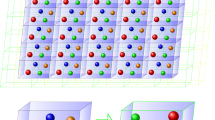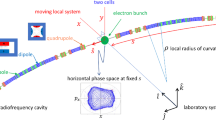Abstract
Geometric phases have natural manifestations in large deformations of geometrically exact rods. The primary concerns of this article are the physical implications and observable consequences of geometric phases arising from the deformed patterns exhibited by a rod subjected to end moments. This mechanical problem is classical and has a long tradition dating back to Kirchhoff. However, the perspective from geometric phases seems to go more deeply into relations between local strain states and global geometry of shapes, and infuses genuinely new insights and better understanding, which enable one to describe this kind of deformation in a neat and elegant way. On the other hand, visual representations of these deformations provide beautiful illustrations of geometric phases and render the meaning of the abstract concept of holonomy more direct and transparent.








Similar content being viewed by others
References
Berry, M.V.: Quantal phase factors accompanying adiabatic changes. Proc. R. Soc. Lond. A 392, 45–57 (1984)
Hannay, J.H.: Angle variable holonomy in adiabatic excursion of an integrable hamiltonian. J. Phys. A 18, 221–230 (1985)
Berry, M.V.: Classical adiabatic angles and quantal adiabatic phase. J. Phys. A 18, 15–27 (1985)
Simon, B.: Holonomy, the quantum adiabatic theorem, and Berry’s phase. Phys. Rev. Lett. 51, 2167–2170 (1983)
Golin, S., Knauf, A., Marmi, S.: The hannay angles: geometry, adiabaticity, and an example. Commun. Math. phys. 123, 95–122 (1989)
Montgomery, R.: The connection whose holonomy is the classical adiabatic angles of hannay and berry and its generalization to the non-integrable case. Commun. Math. phys. 120, 269–294 (1988)
Marsden, J.E.: Lectures on mechanics. Cambridge University Press, Cambridge (1992)
Marsden, J.E., Montgomery, R., Ratiu, T.: Reduction, symmetry, and phases in mechanics. Mem. Am. Math. Soc. 88, 1–110 (1990)
Love, A.E.H.: A Treatise on the Mathematical Theory of Elasticity, 4th edn. Cambridge University Press, Cambridge (1927)
Nizette, M., Goriely, A.: Towards a classification of Euler–Kirchhoff filaments. J. Math. Phys. 40, 2830–2866 (1999)
van der Heijden, G.H.M., Thompson, J.M.T.: Helical and localised buckling in twisted rods: a unified analysis of the symmetric case. Nonlinear Dyn. 21, 71–99 (2000)
Montgomery, R.: How much does the rigid body rotate? A Berrys phase from the 18th century. Am. J. Phys. 59, 394–398 (1991)
Marsden, J.E., Ratiu, T.: Introduction to Mechanics and Symmetry, 2nd edn. Springer, New York (1999)
Simo, J.C.: A finite strain beam formulation. The three-dimensional dynamic problem. Part I. Comput. Methods Appl. Mech. Eng. 49, 55–70 (1985)
Simo, J.C., Marsden, J., Krishnaprasad, P.: The Hamiltonian structure of nonlinear elasticity: the material and convective representations of solids, rods, and plates. Arch. Ration. Mech. Anal. 104, 125–183 (1988)
Arnol’d, V.I.: Mathematical Methods of Classical Mechanics, 2nd edn. Springer, New York (1989)
Spivak, M.: A Comprehensive Introduction to Differential Geometry, Vol. II, 3rd edn. Publish or Perish Inc, Lombard (1999)
Marsden, J., Weinstein, A.: Reduction of symplectic manifolds with symmetry. Rep. Math. Phys. 5, 121–130 (1974)
Simo, J.C., Wong, K.K.: Unconditionally stable algorithms for rigid body dynamics that exactly preserve energy and momentum. Int. J. Numer. Methods Eng. 31, 19–52 (1991)
Landau, L.D., Lifshitz, E.M.: Mechanics, 3rd edn. Butterworth–Heinemann, Oxford (1976)
Misner, C.W., Thorne, K.S., Wheeler, J.A.: Gravitation. W. H. Freeman and Company, San Francisco (1973)
Author information
Authors and Affiliations
Corresponding author
Appendix
Appendix
From the view of mathematics, the exterior differential forms give unique insight into the geometry of the mechanical problem concerned with here. The concept of differential form, and the mathematical formalism for manipulating them, called exterior calculus , arise when concepts such as the work of a force along a path and the flux of a fluid through a surface are generalized to a curved manifold. Readers who have not been familiar with these mathematical tools should refer to the introductory materials presented in excellent books of Arnol’d [16] and Misner et al. [21].
The key to understanding this result is based upon the integration of the right invariant 1-form \( m^{\flat } \) associated with the conserved moment vector \( \varvec{m} \). Identifying the tangent bundle \( T\mathrm {SO}(3)\) with the right trivialization \( \mathrm {SO}(3)\times \mathbb {R}^3 \) (physically, using spatial variable), the vector \( \varvec{\theta }_{\varvec{\varLambda }} \in T_{\varvec{\varLambda }}\mathrm {SO}(3)\) has representation \( \hat{\varvec{\theta }}\varvec{\varLambda } \). Then the 1-form \( m^{\flat } |_{\varvec{\varLambda }} \in T^{*}_{\varvec{\varLambda }} \mathrm {SO}(3)\) at the point \( \varvec{\varLambda } \) is naturally defined via
Consider the following two curves lying on \( \mathrm {SO}(3)\). The first is the physical curve defined by the rotation field of the rod (Fig. 9)
In order to constructed a closed curve, we define an auxiliary curve to connect the two end points of \( \gamma _p \)
which satisfies \( \gamma _p(0) = \gamma _a(0) \) and \( \gamma _{p}(S_{\sigma }) = \gamma _{a}(\alpha ^*) \). Therefore, \( \gamma = \gamma _p - \gamma _a \) (the curve obtained by first going along \( \gamma _p \) and then backward along \( \gamma _a \)) is a closed curve on the \( \mathrm {SO}(3)\). The mystery hidden in Eq. (40) can be revealed through the investigation of the integral of the 1-form \( m^{\flat } \) along \( \gamma \):
First, we consider the integral \( \int _{\gamma _p} m^{\flat } \) along the physical curve. The tangent of \( \gamma _p \) can be expressed as \( \varvec{\omega }\varvec{\varLambda } \). Noting that \( m^{\flat }(\varvec{\omega }\varvec{\varLambda }) = \varvec{m} \cdot \varvec{\omega } = 2 W \), we obtain
Next, for the auxiliary curve \( \gamma _{a} \), its tangent is simply the form \( \varvec{\mu } \exp (\alpha \varvec{\mu }) \). Since
the value of the integral of \( m^{\flat } \) along it can be obtained
Finally, with previous results, the integral around the closed curve \( \gamma \) takes the form
By applying the Stokes’ theorem, we can relate the integral \( \int _{\gamma } m^{\flat } \) to the integral over an arbitrary surface \( \sigma \subset \mathrm {SO}(3)\) encircled by \( \gamma \), i.e., \( \partial \sigma = \gamma \)
In order to obtain the relation Eq. (40), we just need to prove that
We establish the linkage between quantities on the left and right hand side of Eq. (A9). To do so, we first need to compute the 2-form \( {\text {d}}m^{\flat } \). This can be done by employing two arbitrary right invariant vector fields \( \varvec{\xi }_{\varvec{\varLambda }} \) and \( \varvec{\eta }_{\varvec{\varLambda }} \). Bearing in mind that \( [\varvec{\xi }_{\varvec{\varLambda }}, \varvec{\eta }_{\varvec{\varLambda }}] = -{{\mathrm{skew}}}(\varvec{\xi } \times \varvec{\eta }) \varvec{\varLambda } \), we obtain
Note that although this calculation is carried out with help of the right invariant vector field, values of \( {\text {d}}m^{\flat } \) just linearly depend on vectors at \( T_{\varvec{\varLambda }} \mathrm {SO}(3)\). Therefore, \( {\text {d}}m^{\flat } \) is determined via the relation
for all \( \varvec{\xi }_{\varvec{\varLambda }}, \varvec{\eta }_{\varvec{\varLambda }} \in T_{\varvec{\varLambda }} \mathrm {SO}(3)\).
With an appropriate choice of a surface \( \sigma \subset \mathrm {SO}(3)\), the map \( \phi _{\varvec{m}}|_{\sigma } \), which is the restriction of \( \phi _{\varvec{m}} \) on the surface \( \sigma \), is an diffeomorphism to the surface \( \varSigma \subset \mathscr {S}^2\) capping the reduced closed curve defined by image of the map \( \phi _{\varvec{m}} \circ \gamma \). Let \( \psi \) denote the inverse \( (\phi _{\varvec{m}}|_{\sigma })^{-1} : \varSigma \mapsto \sigma \), according to the change of variables theorem, we have
The integral on the surface \( \Sigma \) can be calculated by taking the following strategy. We note that every differential 2-form on the sphere can be written in the form \( f \varepsilon \), where \( \varepsilon \) is the standard area element of \( \mathscr {S}^2\), and f is a scalar function. In particular, the pull back of \( {\text {d}}m^{\flat } \) can be written into this form
where K is a smooth function on the subset \( \varSigma \) of \( \mathscr {S}^2\).
To determine the function K, let us first take an arbitrary point \( \varvec{z} \in \varSigma \) and choose two unit vectors \( \varvec{x}, \varvec{y} \in T_{\varvec{z}} \mathscr {S}^2\) tangent to \( \mathscr {S}^2\) at the point \( \varvec{z} \), which satisfy the relations
where \( \varvec{n} \) is the normal to \( \mathscr {S}^2\) at \( \varvec{z} \). Here two facts need to be keep in mind: the first is that the definition of standard volume form gives us \( \varepsilon (\varvec{x}, \varvec{y}) = 1 \); the second is that the matrix \( \psi (\varvec{z}) \) rotate the normal \( \varvec{n} \) to the direction of \( \varvec{m} \), i.e., \( \varvec{\mu } = \psi (\varvec{z}) \varvec{n}\).
Let us denote \( \varvec{\varLambda } \) to be the rotation matrix \( \psi (\varvec{z}) \), and take the vectors \( \varvec{\xi }_{\varvec{\varLambda }}, \varvec{\eta }_{\varvec{\varLambda }} \in T_{\varvec{\varLambda }}\mathrm {SO}(3)\) which are the images of the vectors \( \varvec{x}, \varvec{y} \) under the tangent map \( T_{\varvec{z}} \psi \)
Since the value of \( \psi ^{*} {\text {d}}m^{\flat }(\varvec{x}, \varvec{y}) \) is defined by the equation
and \( \varepsilon (\varvec{x}, \varvec{y}) = 1 \), the value K at the point z can be determined by the relation
By recalling that \( \phi _{\varvec{m}}(\varvec{\varLambda }) = \varvec{\varLambda }^{\mathrm {T}}\varvec{m} \), for an arbitrary vector \( \varvec{\theta }_{\varvec{\varLambda }} \in T_{\varvec{\varLambda }}\mathrm {SO}(3)\), the transformation of \( \varvec{\theta }_{\varvec{\varLambda }} \) under the tangent map of \( \phi _{\varvec{m}}\) at \( \varvec{\varLambda } \) takes a simple form
Therefore, we have
By taking the cross product of \( \varvec{m} \times \varvec{\xi } \) and \( \varvec{m} \times \varvec{\eta } \), we find
However, with the help of the identity of the cross product and Eq. (A10) concerning \( {\text {d}}m^{\flat } \), the left hand side can also be expressed in the form
Comparison of \( \varvec{\mu } \) and \( {\text {d}}m^{\flat }(\varvec{\xi }_{\varvec{\varLambda }}, \varvec{\eta }_{\varvec{\varLambda }}) \varvec{m} \) leads to
Since the choice of \( \varvec{z} \) is arbitrary, this result holds for all poinst \( \varvec{z} \in \varSigma \). Hence, K is a constant function, and the 2-form \( \psi ^{*} {\text {d}}m^{\flat } \) can be expressed in the form
With this result, the integral \( \int _{\sigma } {\text {d}}m^{\flat } \) can be carried out in the following manner
Remembering that the solid angle A can be expressed as \( A = {\text {area}}(\Sigma )/M^2 \), we arrive at the equation
Therefore, the demonstration of phase formula (40) is completed.
In summary, the phase formula (40) is established through a direct application of Stokes’ theorem on the integral of differential 1-form \( m^{\flat } \) along the path \( \gamma \) defined at the beginning of this appendix (see the Eq. (A8)). The surface integral is directly related to the global geometric property of the distribution of the stress field \( \varvec{M} \) along the rod. After careful analysis, we find it could be expressed as the product of the magnitude of the moment and the solid angle enclosed by the closed orbit described by the stress vector \( \varvec{M} \).
Rights and permissions
About this article
Cite this article
Zhong, P., Huang, G. & Yang, G. On the geometric phase in the spatial equilibria of nonlinear rods. Acta Mech. Sin. 33, 457–471 (2017). https://doi.org/10.1007/s10409-016-0625-8
Received:
Revised:
Accepted:
Published:
Issue Date:
DOI: https://doi.org/10.1007/s10409-016-0625-8





